This post is also available in:
 Deutsch (German)
Deutsch (German)
The interest of documenta visitors in the works of the collective Taring Padi is enormous; according to the documenta press office, the former indoor swimming pool is one of the most visited art venues. For weeks, the artists had made headlines around the world because of their “People’s Justice” banner. Fortunately, the controversial mural, which was taken down after accusations of anti-Semitism, was only one of several of their works in Kassel, so that visitors to Schwimmhalle Ost now have the opportunity to take a direct and closer look at the objects at their leisure.
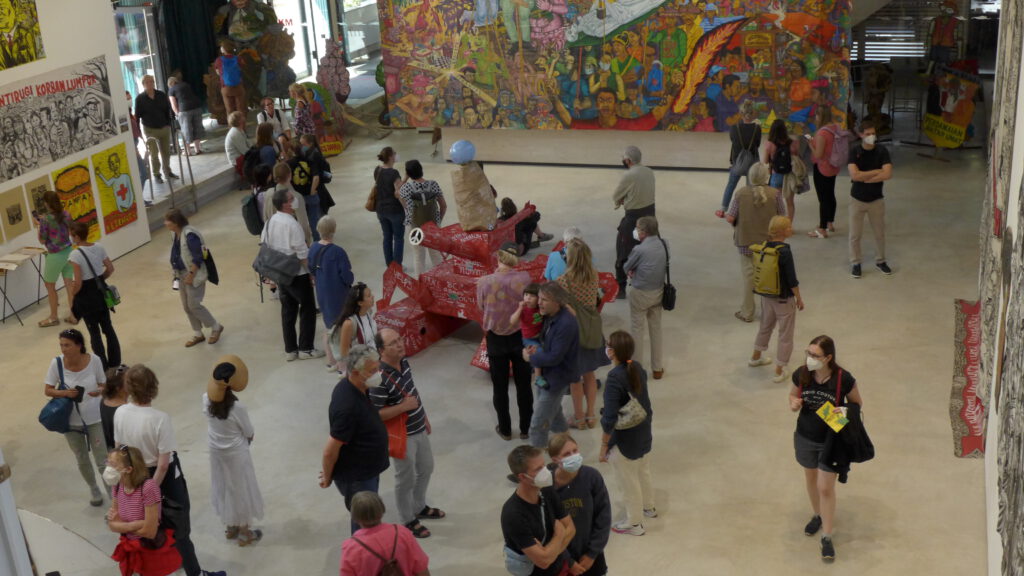
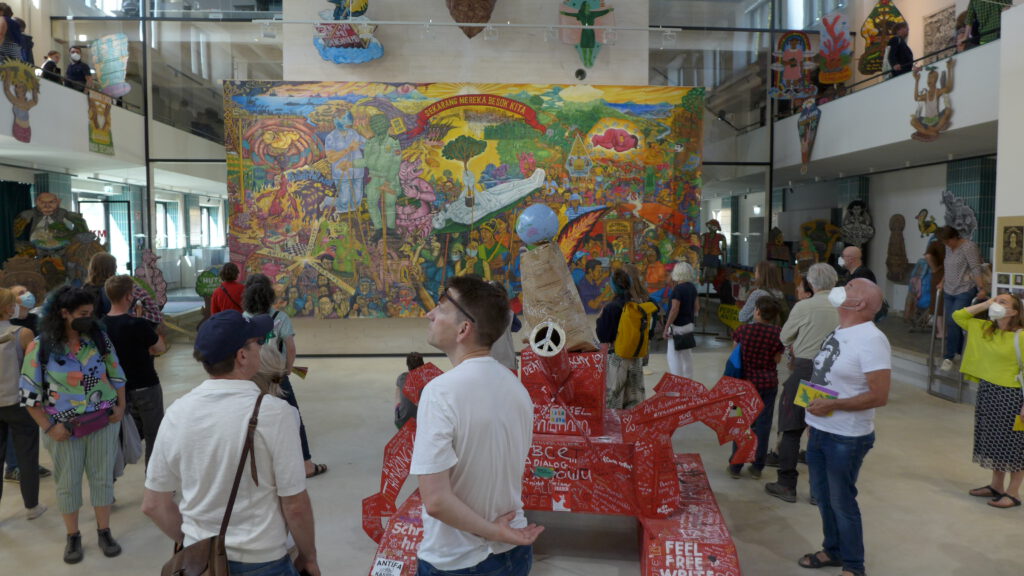
The atmosphere during my visit was relaxed, some visitors sought conversation with the activists, who were able to sell many of their prints and T-shirts. Among them was Sri Maryanto, a Taring Padi artist who has lived in Munich for ten years and speaks fluent German. I am curious and excited about this collective from Indonesia that we know so little about. What drives them? Where do they live? What do they stand for? How does collaboration work in a collective? The artist says he is part of the “second generation of Taring Padi,” which practically means he didn’t work on the controversial banner 20 years ago. This was on the day before his departure, after which I sent him some questions, which Sri Maryanto answered in detail.
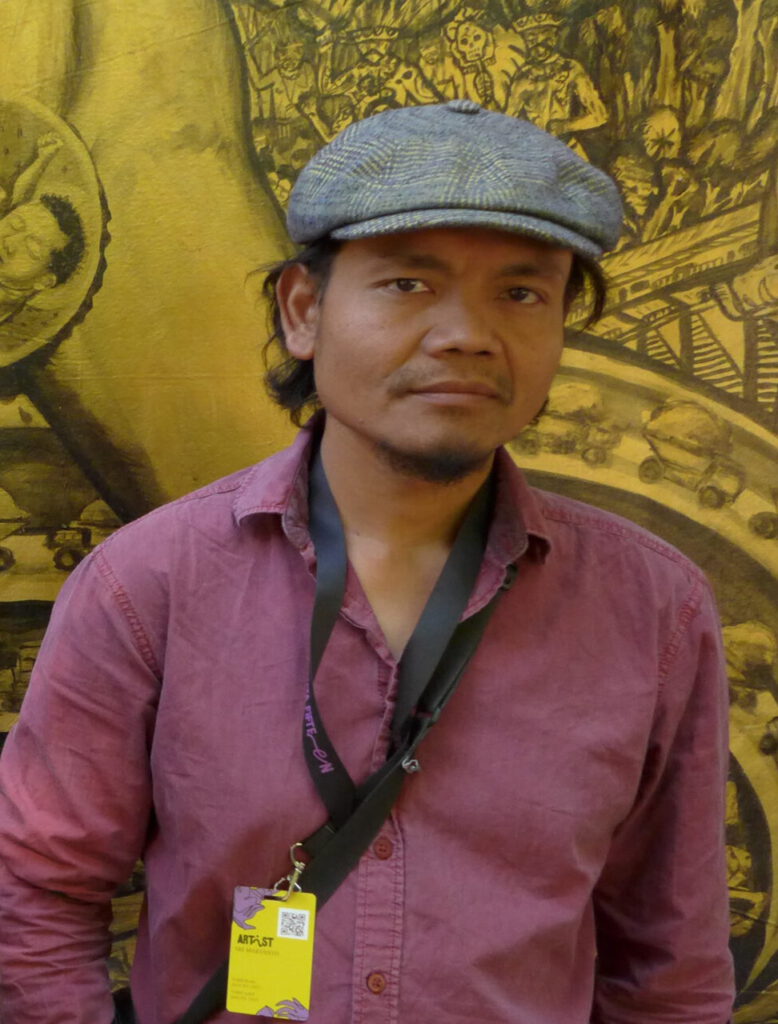
Kay Dethlefs: How did you come to Taring Padi? And what do you associate with Taring Padi?
Sri Maryanto: “I started studying art in Yogyakarta in 1999. At that time I founded the group Sanggar Caping with fellow students. With this collective I got to know Taring Padi, the collectives often collaborated. In 2004, when Taring Padi’s structure was changed from a closed organization to a collective, I began to actively participate.”
What does the term Taring Padi mean, can it be translated?
Sri Maryanto: “Taring Padi” as a term is a small hair on the tip of unhusked rice grain. When the ear is harvested, this small hair comes off and flies away, if it touches the skin, an allergic reaction or itching is caused, similar to itching powder. This is the philosophy of Taring Padi, as small as we are the skin of the great powers we criticize is irritated. Taring: fangs (canines), Padi: rice ear.
What values do you associate with Taring Padi? Is there a kind of philosophy that Taring Padi represents? Sri Maryanto: “Justice, friendship and solidarity. Art for Taring Padi is a political tool to represent our idea against exploitation and violence. Liberation art.”
Where do the members of Taring Padi live everywhere?
Sri Maryanto: “In the beginning we all lived in Yogyakarta, where we met, but now we live spread all over the world. Even though most of us still live in Yogyakarta, Indonesia, where our base camp is located. Some live abroad for example in Germany, Australia, America, England, Sweden and Timor Leste.”
What exactly do the artists do in each of these places?
Sri Maryanto: “Each member of the collective has their own life like any other people. They work, most are active as artists, many have other jobs to make a living.”
For example, what do you do and produce as an artist in Munich?
Sri Maryanto: “I studied free art in painting and graphics, last February I graduated with a diploma from AdBK Munich. In addition to painting, I do printmaking, such as letterpress, planographic, silkscreen, and intaglio, but also objects.”
To what extent is it a collective, how does the collective come together?
Sri Maryanto: “All issues are discussed in the collective, all decisions are made together in our collective. The voices of all members are equal. Collectives are formed through friendship and the common ideology. In our collective of artists there are no individual names within the art. All works created for and within the collective are collective works, the artist’s name no longer matters.”
How does the collective exchange ideas – at such a great distance?
Sri Maryanto: “Nowadays, fortunately, there are technologies that solve us the problems in communication at a distance.”
And then how do they work together? What are the topics?
Sri Maryanto: “We first discuss the topic, often an expert from outside the collective is invited, with whom a topic is discussed in depth. After that, the tasks are distributed. Some artists develop the composition and the sketch of a work. Then together the composition is transferred to the image carrier (canvas, hardboard, etc.), then they paint together. Of course, each artist has his own technique, the individual brushstroke, but through the joint work this is relativized in the totality. It often comes to improvisations but the composition, or sketch developed at the beginning remains.”
“We show solidarity with people who experience social or economic injustice and give them a (visual) voice. We discuss social and political injustices, address environmental problems and their connections with business and technology. Here we are also not afraid to attack individual companies. The goal of our work is that the injustice gets more attention from the public and ideally a dialogue takes place to solve this problem.”
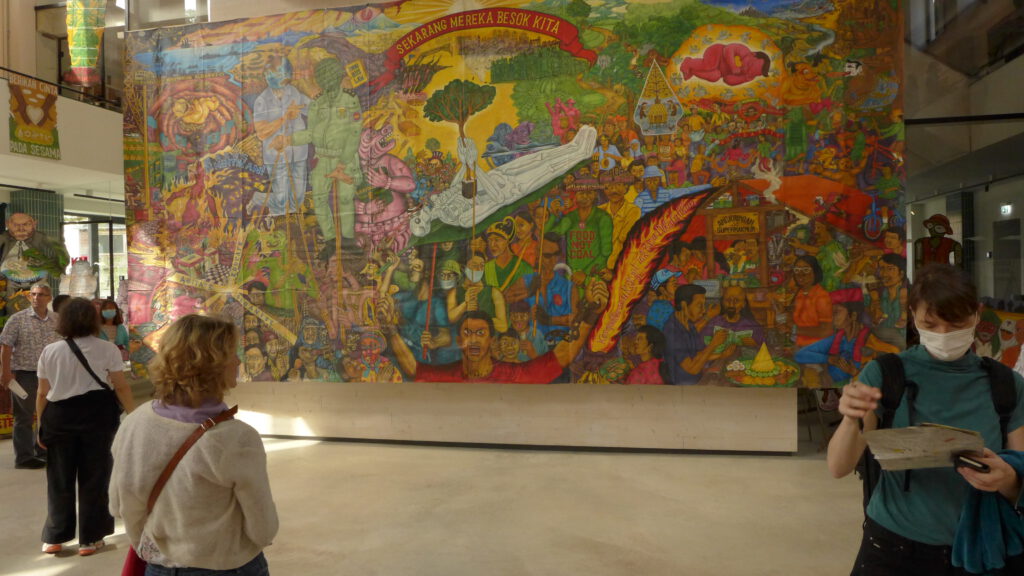
A question about a large mural in the East Swimming Pool. That’s a new work. Where was it actually created? Or how did it happen in practice?
Sri Maryanto: “The painting “Sekarang Mereka Besok Kita” was created in Indonesia. Fortunately, we have a base camp. Regular meetings are held there to discuss and implement projects.”
What is the background and general message of this new mural?
Sri Maryanto: “The translation of “Sekarang Mereka, Besok Kita” is “Now it hits them, tomorrow it hits us all”. It is to be understood as an act of solidarity with oppressed people who suffer from the greedy, capitalist system to which we too may eventually fall victim. The phrase is also to be understood as a warning before the great danger of environmental problems, the effects of which will affect all of us in the future, without exception.”

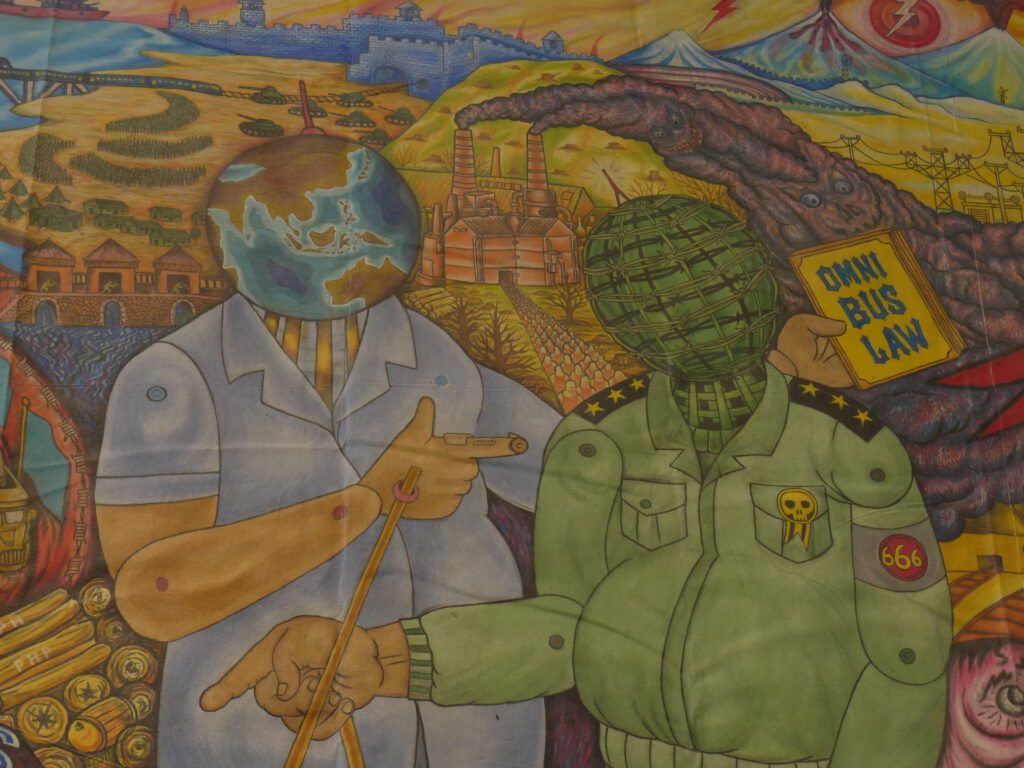
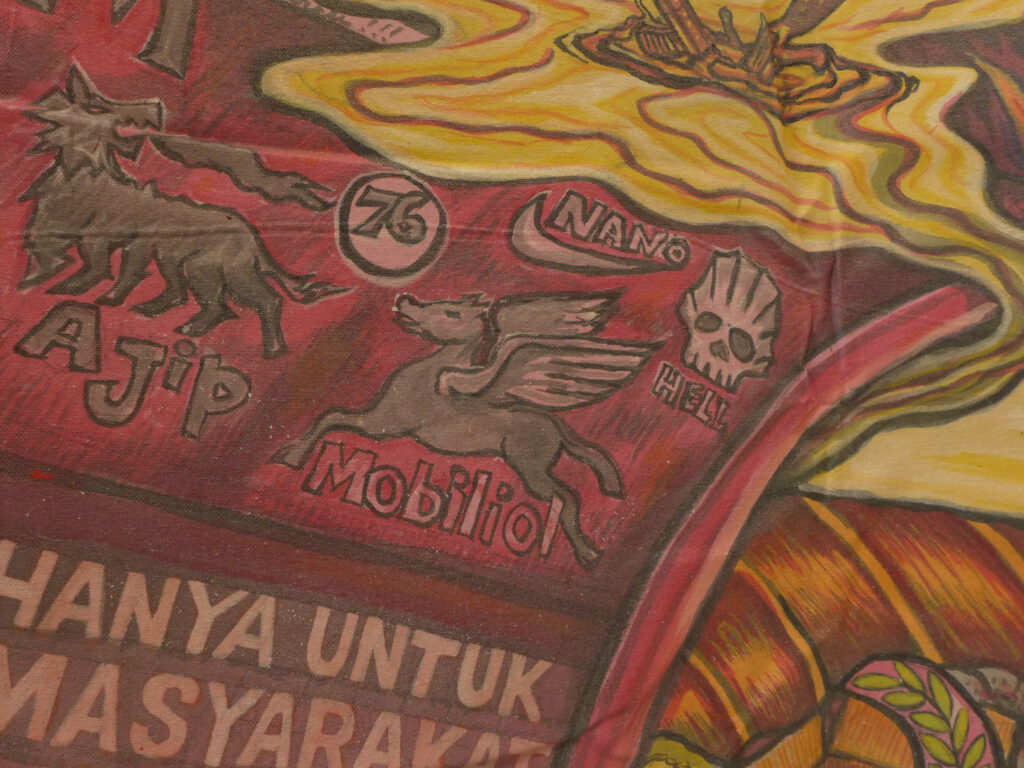
“We want to be remembered as a collective that uncompromisingly denounces and fights injustice.”
– Sri Maryanto, Taring Padi
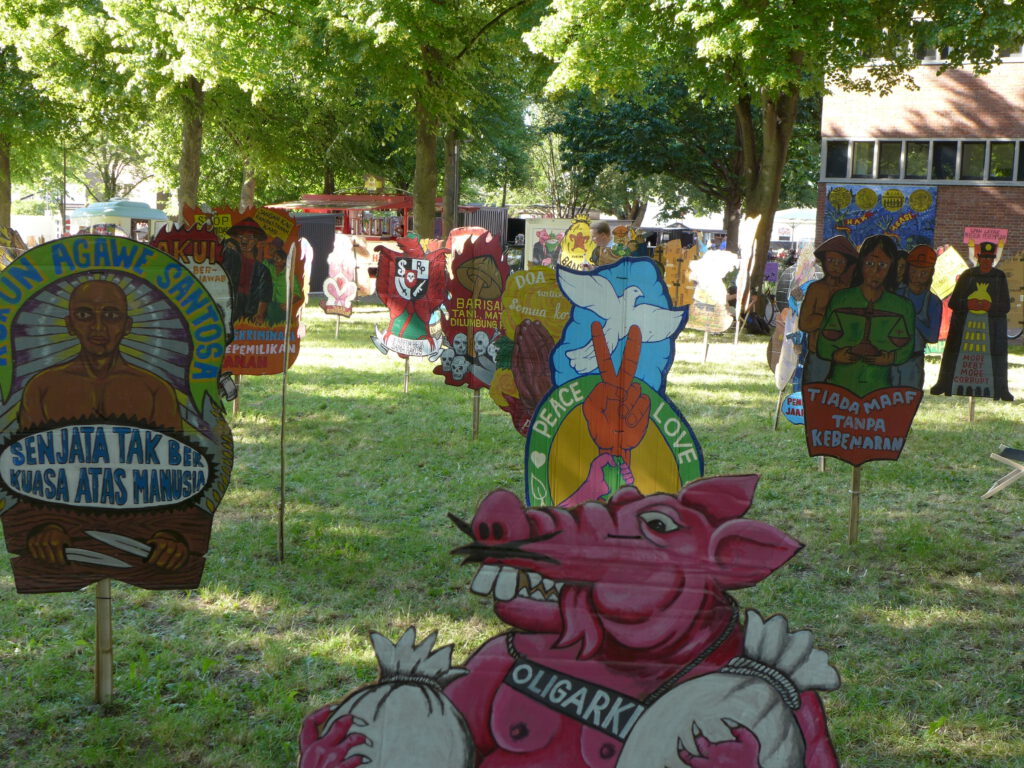
In front of the swimming hall there are these many colorful displays, what can you say about them? How can you name and describe this art form, which opposes existing unjust political conditions?
Sri Maryanto: “The stand-ups are wayang kardus, cardboard figures, inspired by the classical Javanese shadow puppets. In addition to the statements visualized by the wayang kardus, they also serve quite banally as a source of shade during a demonstration. At the same time, in case of emergency, we can protect ourselves from the arbitrariness of police violence with the bamboo sticks. In addition, a demonstration that makes use of many such wayang kardus appears much larger, we thereby virtually double the crowd.”
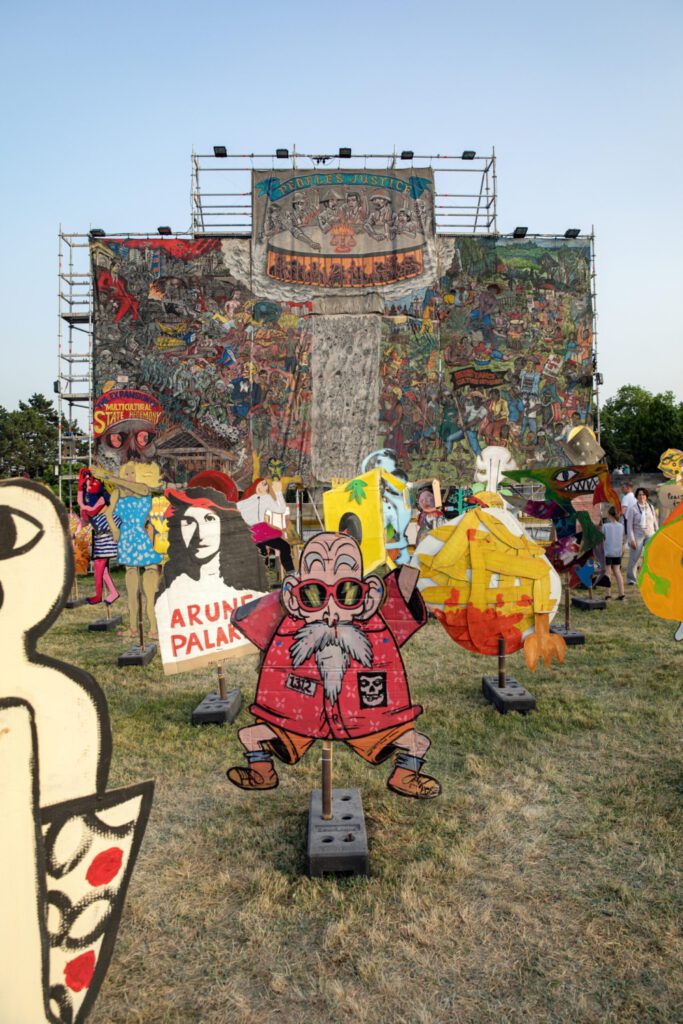
“Our actual highlight for Documenta fifteen was the solidarity action “1000 Wayang Kardus”. These cardboard figures were created in different workshops around the world and were set up and displayed at Friedrichsplatz. The themes of the Wayang Kardus were developed by the workshop participants, each one designed the wayang on the topic that concerned or engaged them.”
A question about the history of Taring Padi. Where did it originate? What was the trigger historically?
Sri Maryanto: “The first generation Taring Padis were born and raised in a military dictatorship. As art students, they were actively involved in the overthrow of the dictator Suharto. During the military dictatorship, the people were subject to censorship. With the fall of the dictator, a new era began; we were able to raise our voices, to draw attention to injustices. The cries we swallowed during the military dictatorship could now be shouted out with full force.”
“Art is our political tool to give voice to the oppressed people. Liberation art.”
– Sri Maryanto, Taring Padi
In the video about Taring Padi that can be seen at the entrance to the East Indoor Pool, one artist says that it was life-threatening to demonstrate at the time. There were snipers. How can you paraphrase that situation?
Sri Maryanto: “No one who was critical of the government of the time was safe. The community in the struggle strengthened our will and courage to continue protesting.”
Is Taring Padi actually politically active in Indonesia at this time? If so, in what ways?
Sri Maryanto: “Our art has been political since the beginning and without exception. Art is our political tool to give voice to the oppressed people. Liberation art.”
After the documenta, what do you want to be remembered by Taring Padi, what do you want to convey and give away?
Sri Maryanto: “We want to be remembered as a collective that uncompromisingly denounces and fights injustice. Through the expanded network, and collaboration, we can gain more attention. Documenta has shown us again how important it is to learn with, from and together to realize a better world. Now it’s society’s turn.”
Thank you.
Here is the link to my conversation with Mohammad Yusuf of Taring Padi. The artist collaborated on the controversial “People’s Justice” mural back in the day, which was about 20 years ago.
https://hamburgarts.de/documenta-fifteen-interview-taring-padi/


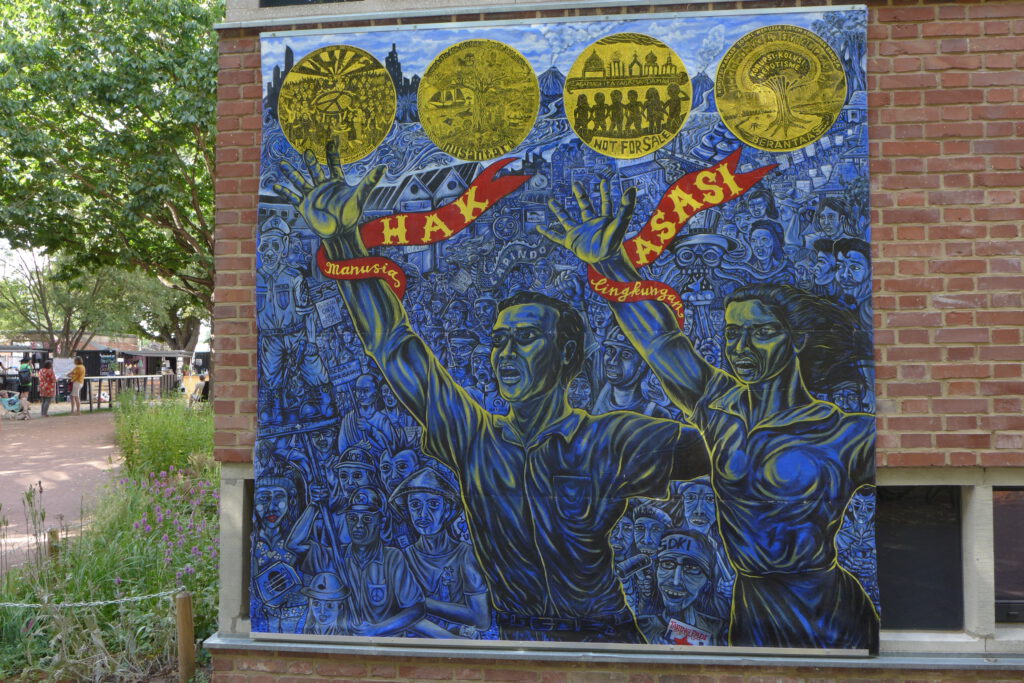




Comments by Kay Dethlefs